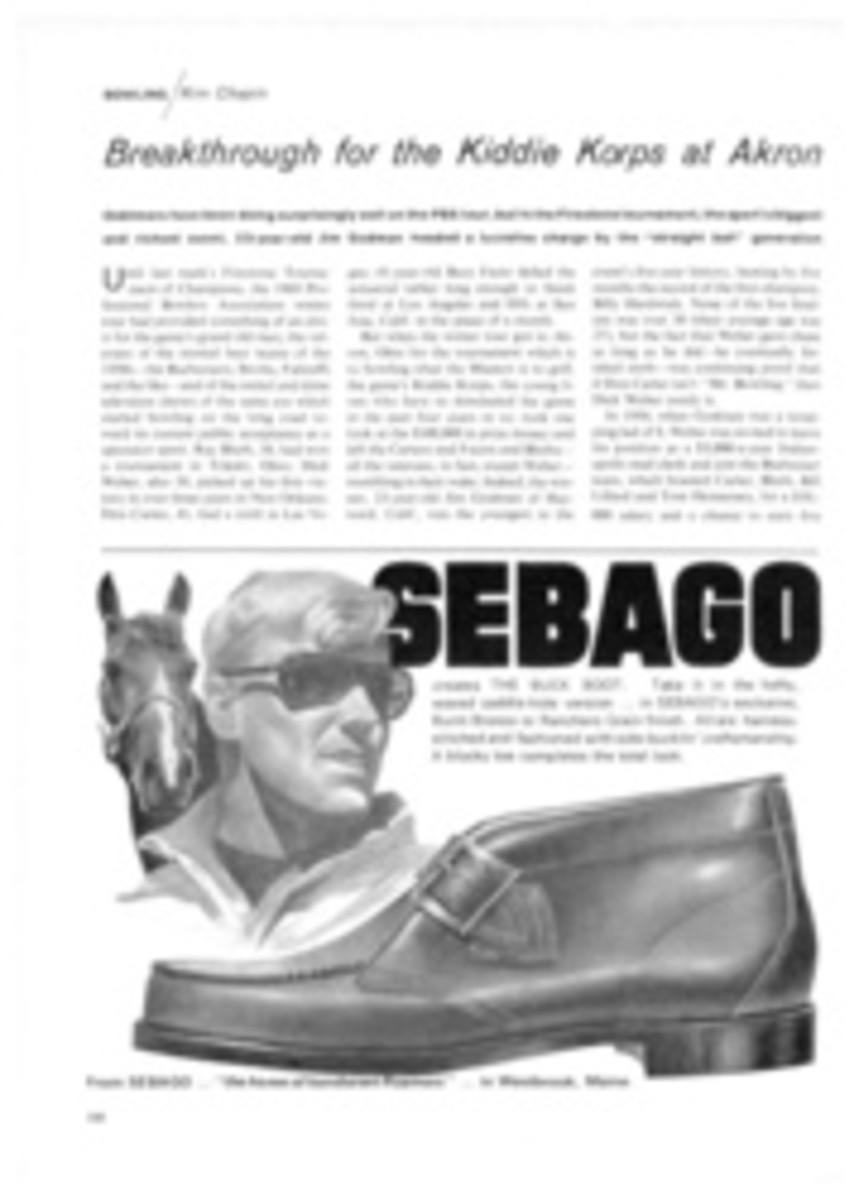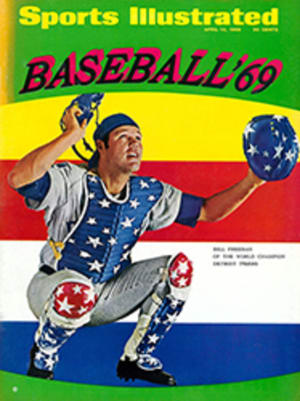
Breakthrough for the Kiddie Korps at Akron
Until last week's Firestone Tournament of Champions, the 1969 Professional Bowlers Association winter tour had provided something of an elixir for the game's grand old men, the veterans of the storied beer teams of the 1950s—the Budweisers, Strohs, Falstaffs and the like—and of the nickel and dime television shows of the same era which started bowling on the long road toward its current public acceptance as a spectator sport. Ray Bluth, 39, had won a tournament in Toledo, Ohio; Dick Weber, also 39, picked up his first victory in over three years in New Orleans; Don Carter, 41, had a sixth in Las Vegas; 61-year-old Buzz Fazio defied the actuarial tables long enough to finish third at Los Angeles and fifth at San Jose, Calif. in the space of a month.
But when the winter tour got to Akron, Ohio for the tournament which is to bowling what the Masters is to golf, the game's Kiddie Korps, the young lions who have so dominated the game in the past four years or so, took one look at the $100,000 in prize money and left the Carters and Fazios and Bluths—all the veterans, in fact, except Weber—trembling in their wake. Indeed, the winner, 23-year-old Jim Godman of Hay-ward, Calif., was the youngest in the event's five-year history, beating by five months the record of the first champion, Billy Hardwick. None of the five finalists was over 30 (their average age was 27), but the fact that Weber gave chase as long as he did—he eventually finished sixth—was continuing proof that if Don Carter isn't "Mr. Bowling," then Dick Weber surely is.
In 1954, when Godman was a strapping lad of 8, Weber was invited to leave his position as a $3,000-a-year Indianapolis mail clerk and join the Budweiser team, which boasted Carter, Bluth, Bill Lillard and Tom Hennessey, for a $10,000 salary and a chance to earn five grand more each year in tournament winnings. Five years later the PBA was formed, and suddenly there was some real money to be made—by now nearly $2 million in tournament purses. Weber, getting strength from God knows where—he packs 125 pounds on a 5'10" frame; his legs are the size of an average man's arms—did brilliantly. Through early 1966 he had won 17 tournaments, a record, and taken $250,000 in prize money, also a record. But somewhere along the way a couple of funny things happened. The first was that bowling was enjoying a boom and junior leagues were producing youngsters who learned the game quickly. There had been a dozen good tournament bowlers a decade before; now there were 40. "What it took Weber 15 years to learn," said Jim Stefanich, 27, the third-place finisher in Akron, "we picked up in three." Then the traditional wood pins turned into plastic, and the sharp hook which Weber and others of his generation had grown up with wasn't getting enough pins down. The youngsters were scoring well with a straight ball, which required more muscle but less art.
"I got psyched," Weber said. "I went to the straight ball and for those three years I couldn't do a thing. People said I was too old, over the hill, too rich. They said I didn't care any more. But I still wanted to win. I was losing my mind."
Last summer Weber reverted to the hook—and he began scoring again. Through New Orleans, the last tournament before Akron, Weber had won over $20,000 and at the Tournament of Champions came out on top in the 24-game round of medal qualifying. He felt good—the capacity crowds were behind him almost to the point of distracting him—and he was hungry, having gotten a sniff of the money in 1965 and 1966, when he finished second. Midway through the week he told a friend, "More than any other tournament, I want this one."
But in the 24-game match-play round, in which 50 bonus pins for a victory were added to actual pinfall, the amiable string bean began to sag. At the end of the first eight-game block he had dropped to sixth and could not improve his position in the second eight-game session. But going into the final block he was only 128 pins out of fifth place and had a chance at the big money and even the title. His first three games were superb—259, 236 and 205—but he gained back only 30 of those pins. His fourth game was an impressive 224. However, Barry Asher of Los Angeles, not yet 23, threw a 248 at him and took away the crucial bonus points. Weber was through.
Meanwhile, the other youngsters had charged and the top five positions were filled by Godman, who had gone 8-0 in his last block, Dave Soutar, 29, Stefanich, Wayne Zahn, 28, and Don Johnson, also 28. With Weber on the sidelines as the alternate, the five finalists went at each other in a nice, neat way especially devised to fit into a nice, neat 90-minute television package: No. 5 vs. No. 4, the winner vs. No. 3 and so forth, in a series of one-game knockouts. After 48 games of relatively tension-free bowling, all of a sudden there was some electricity. Some of the bowlers tightened under the pressure. Others, most notably Godman, did not.
The first game was no contest. Zahn, of Atlanta, opened with five strikes and defeated Johnson 258-193. Against Stefanich he kept right on going—until the 10th frame. To that point he had thrown 17 strikes in 21 frames. With Stefanich in at 237, Zahn needed a spare and nine pins to tie, a spare and a strike to win. He got the spare, but on his last ball he "left a bucket," namely the 2-4-5-8, and lost by three pins, 237-234. That put Stefanich, the 1967 Firestone champion, against Dave Soutar, of Gilroy, Calif., who left an awkward split in the 10th frame, did not convert and was a 227-201 loser.
Through all of this, Godman, a muscular 6-footer who throws the ball harder than perhaps anyone else on the tour, had been nervously waiting his turn, occasionally practicing on far lanes but more often checking the scoreboard. "I thought there was no way I could win," he said. "They were all bowling good. I knew I would have to throw a big game, like around 250, to beat Stefanich. I was also having a lot of trouble concentrating."
It was Stefanich, however, who seemed edgy as they hooked up. He spared the second, third and fifth frames before settling down, while Godman strung together seven strikes. By then the only question remaining was whether Godman would pick up an extra $10,000 by rolling a perfect game on television. The string ended in the eighth frame when the 10 pin refused to fall, but Godman was a 266-228 winner and $25,000 richer.
Godman has had a strange career in the PBA. He was its Rookie of the Year in 1965, but nearly had to quit the tour last summer because he was about to go broke. "I was down to my last $1,000," he said, "enough for four tournaments. I didn't win anything in the first three, just enough in the fourth to keep me going." Then he got hot and wound up winning $21,125 during the year.
Last week's paycheck solves any immediate financial problems, and at 23 his career is really just beginning. The Zahns, Stefaniches and Johnsons have their best years ahead, and all the old guardsmen can do is sit back and wonder why they were born too soon.

